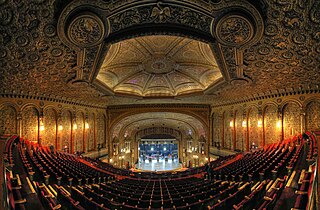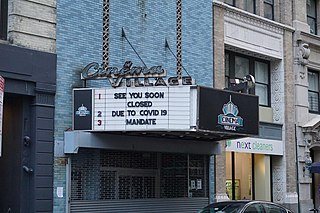
A movie theater or cinema, also known as a movie house, cinema hall, picture house, picture theater, the pictures, or simply theater, is a business that contains auditoriums for viewing films for public entertainment. Most are commercial operations catering to the general public, who attend by purchasing tickets.
Landmark Theatres is a movie theatre chain founded in 1974 in the United States. It was formerly dedicated to exhibiting and marketing independent and foreign films. Landmark consists of 34 theatres with 176 screens in 24 markets. It is known for both its historic and newer, more modern theatres. Helmed by its President, Kevin Holloway, Landmark Theatres is part of Cohen Media Group.

Maurice Kanbar was an American entrepreneur and inventor who lived in San Francisco, California. He was particularly well known for his creation of SKYY vodka and was also noted for his extensive real estate investments.

The Film Forum is a nonprofit movie theater at 209 West Houston Street in Greenwich Village, Manhattan, New York City. It is a four-screen cinema open 365 days a year, with 280,000 annual admissions, nearly 500 seats, 60 employees, 4,500 members, and an operating budget of $5 million. It is the only autonomous nonprofit cinema in New York City and one of the few in the United States.

Film Streams is a nonprofit arts organization in Omaha, Nebraska which oversees two cinemas: the Ruth Sokolof Theater, in North Downtown Omaha, and the historic Dundee Theater, Omaha's longest surviving neighborhood cinema. It receives funding from corporate and individual donors, members, and the government.

A multiplex is a movie theater complex with multiple screens or auditoriums within a single complex. They are usually housed in a specially designed building. Sometimes, an existing venue undergoes a renovation where the existing auditoriums are split into smaller ones, or more auditoriums are added in an extension or expansion of the building. The largest of these complexes can sit thousands of people and are sometimes referred to as a megaplex.

The Bleecker Street Cinema was an art house movie theater located at 144 Bleecker Street in Manhattan, New York City, New York. It became a landmark of Greenwich Village and an influential venue for filmmakers and cinephiles through its screenings of foreign and independent films. It closed in 1990, reopened as a gay adult theater for a short time afterward, then again briefly showed art films until closing for good in 1991.

The River Oaks Theatre is a historic movie theater located in the River Oaks Shopping Center in the Neartown community in Houston, Texas, United States, east of the River Oaks community. The theater has three projection screens; one large screen, downstairs, and two smaller screens, upstairs.

The Senator Theatre is a historic Art Deco movie theater on York Road in the Govans section of Baltimore, Maryland. It is the oldest operating movie theater in central Maryland and is listed on the National Register of Historic Places and is a designated Baltimore City Landmark.

The United Palace is a theater at 4140 Broadway in the Washington Heights neighborhood of Manhattan in New York City. The theater, occupying a city block between Broadway, Wadsworth Avenue, and West 175th and 176th Streets, is both a house of worship and a cultural center. The architect, Thomas W. Lamb, designed the theater as a movie palace, which opened on February 22, 1930, as one of five Loew's Wonder Theatres in the New York City area. The theater's interior decor, incorporating elements of numerous architectural styles, was supervised by Lamb and Harold Rambusch.

The Paris Theater is a 535-seat single-screen art house movie theater, located in Manhattan in New York City. It opened on September 13, 1948. It often showed art films and foreign films in their original languages. Upon the 2016 closure of the Ziegfeld, the Paris became Manhattan's sole-surviving single-screen cinema. Since November 2019, it has been operated by Netflix, playing first-run releases alongside repertory programming.

VIA 57 West is a residential building at 625 West 57th Street, between 11th and 12th Avenues, in the Hell's Kitchen neighborhood of Manhattan in New York City. The pyramid shaped tower block or "tetrahedron", designed by the Danish architecture firm Bjarke Ingels Group (BIG), rises 467 ft (142 m) and is 35-stories tall.

Charles Steven Cohen is an American real estate developer and film distributor.

Village East by Angelika is a movie theater at 189 Second Avenue, on the corner with 12th Street, in the East Village of Manhattan in New York City. Part of the former Yiddish Theatre District, the theater was designed in the Moorish Revival style by Harrison Wiseman and built from 1925 to 1926 by Louis Jaffe. In addition to Yiddish theatre, the theater has hosted off-Broadway shows, burlesque, and movies. Since 1991, it has been operated by Angelika Film Center as a seven-screen multiplex. Both the exterior and interior of the theater are New York City designated landmarks, and the theater is on the National Register of Historic Places.

Metrograph is an independent two-screen movie theater located at 7 Ludlow Street on the Lower East Side of Manhattan. As a theater, it focuses primarily on repertory cinema screenings as well as occasionally hosting new premieres and Q&A events.

An independent movie theater or indie cinema is a movie theater which screens independent, art house, foreign, or other non-mainstream films. It can be contrasted with a mainstream theater, which is more likely to screen blockbusters and other popular films.

Nitehawk Cinema is a dine-in independent movie theater in Brooklyn, New York City. It operates two locations, in the neighborhoods of Williamsburg and Park Slope. The theater, which offers a menu of food and drinks that can be ordered and consumed while patrons view films, was the first liquor licensed movie theater in the state of New York, and the first movie theater in New York City to offer table service.

Cinema Village is a three-screen movie theater in Greenwich Village, New York. It is the oldest continuously operated cinema in Greenwich Village.

The Metro Theater is a defunct movie theater at 2626 Broadway on the Upper West Side of Manhattan in New York City. It was designed by architecture firm Boak and Paris and built between 1932 and 1933. The theater is designed in the Art Deco style and originally contained 550 seats. Although the theater's interior was demolished after it was closed in 2005, the original facade remains intact and is a New York City designated landmark.


















